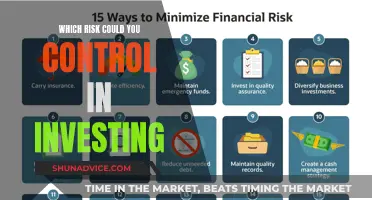
Investing is a great way to grow your wealth over time and there are a variety of investment options available, from safe lower-return assets to riskier, higher-return ones. It's important to understand the pros and cons of each investment option and how they fit into your overall financial plan. Here are some things to consider when deciding what to invest in to make a living:
- Risk tolerance: Are you willing to take on more risk for potentially higher returns, or do you prefer a more conservative portfolio?
- Time horizon: Do you need the money in the short-term or long-term? This will impact the type of investments that are suitable for you.
- Knowledge: Do you have the knowledge and time to research and understand different investment options? If not, consider investing in diversified funds or seeking advice from a financial professional.
- Investment amount: How much money can you invest? This may impact the types of investments that are available to you.
Some common investment options include:
- Stocks: Offer the potential for higher returns but come with higher risk and volatility.
- Mutual funds and exchange-traded funds (ETFs): Provide diversification and are managed by investment professionals. ETFs are typically more flexible and have lower fees than mutual funds.
- Bonds: Considered a safer investment option, bonds offer fixed income and lower volatility but may have lower returns than stocks.
- Real estate: Investing in property can provide stable income through rents and the potential for capital growth.
- High-yield savings accounts and certificates of deposit (CDs): Offer relatively low returns but are generally considered safe investments.
- Cryptocurrencies: A relatively new form of investment that can be incorporated into a diversified portfolio.
Remember, investing carries risk and it's important to do your own research or seek professional advice before making any investment decisions.
What You'll Learn

High-yield savings accounts
Here's a detailed look at high-yield savings accounts as an investment option:
Who are they good for?
Benefits of High-Yield Savings Accounts:
- Higher Interest Rates: Online banks typically offer much higher interest rates than traditional banks, allowing your savings to grow faster.
- Accessibility: High-yield savings accounts provide easy access to your funds, often through online transfers or ATMs.
- Low Risk: These accounts are considered low-risk investments, making them suitable for risk-averse individuals.
- FDIC Insurance: Many high-yield savings accounts are FDIC-insured, protecting your deposits up to certain limits.
Things to Consider:
- Inflation Risk: High-yield savings accounts do carry the risk of losing purchasing power over time if the interest rates fail to keep up with inflation.
- Limited Returns: While these accounts offer higher interest rates than traditional savings accounts, they may not provide the highest returns compared to other investment options.
Where to Open a High-Yield Savings Account:
When considering a high-yield savings account, online banks are generally the best option, as they tend to offer more competitive rates. However, you can also explore options with your local bank or credit union, although the rates may not be as attractive.
In summary, high-yield savings accounts offer a safe and accessible investment option with decent returns. They are ideal for short-term financial goals, building an emergency fund, or for those who prefer a more conservative approach to investing. While they may not provide the highest returns, they strike a good balance between risk and return, making them a solid choice for individuals seeking a combination of growth and safety for their investments.
Manager's Investment: Broadest Responsibilities, Greatest Impact
You may want to see also

Exchange-traded funds (ETFs)
When considering investing in ETFs, it is important to understand their advantages and disadvantages. One of the key benefits of ETFs is their diversification. By pooling investor money to purchase a diverse range of securities, ETFs reduce the risk associated with investing in individual stocks. This diversification also allows investors to gain exposure to various industries and sectors, providing a more well-rounded investment portfolio. Additionally, ETFs are known for their lower fees compared to other investment options, making them a cost-effective choice.
Another advantage of ETFs is their flexibility. Investors can choose from a wide range of ETFs, including those focused on specific industries, market indices, or investment strategies. This flexibility enables investors to tailor their investments to their specific needs and preferences. ETFs also tend to have lower minimum investment requirements than mutual funds, making them more accessible to a broader range of investors.
However, it is important to consider the potential drawbacks of ETFs. While they offer diversification, the performance of an ETF is still tied to the underlying securities it holds. As a result, investors are exposed to market risk, and the value of their investment may fluctuate. Additionally, ETFs may not be suitable for short-term investment horizons as they are typically designed for long-term growth.
When investing in ETFs, it is crucial to conduct thorough research and due diligence. This includes evaluating the fund's investment strategy, historical performance, fees, and the underlying securities included in the fund. It is also important to consider the reputation and track record of the fund manager or investment firm offering the ETF.
In conclusion, Exchange-traded funds (ETFs) offer a balanced approach to investing, providing diversification and flexibility while being traded on stock exchanges for added liquidity. By understanding the benefits and drawbacks of ETFs, investors can make informed decisions about including them in their investment portfolios.
Adjusting Your Acorns Investment Portfolio: A Quick Guide
You may want to see also

Dividend stocks
- Don't just look for the highest yields. Income-focused fund managers look for future dividend growth. Some sectors that offer better dividend-growth potential are technology, energy, and materials, versus the typical utility sector.
- Focus on steady dividend growers. Target companies whose share prices will rise as they increase their dividends. Your yield, based on your purchase price, will grow over time.
- Invest in companies that are restoring their payouts. If you buy shares that pay a small dividend, the yield on your original investment may soar if the firm boosts the rate.
- Keep an eye out for first-timers. A company initiating a dividend yield usually indicates that business is good and they have extra money to give back to shareholders.
- Cautiously venture overseas. Foreign stocks tend to offer more enticing dividend yields than U.S. companies, but many countries withhold taxes on dividends paid to U.S. shareholders.
- Avoid "overpayers." If a company pays out too much of its earnings to boost or maintain its dividend, they may not have enough earnings left over to generate future growth. Be wary of companies paying out 70-100% of their earnings.
The best dividend stocks may not be the ones with the highest yield. A high dividend yield can indicate that the payout is unsustainable or that the company is going into debt to pay dividends. The stocks with the highest yields may not fit your investment goals or existing portfolio. For example, if you already have an energy-heavy portfolio, you may not want to add more energy stocks.
In summary, dividend stocks can be a good choice for investors looking for passive income. They provide regular cash payments and can add stability to your portfolio. When investing in dividend stocks, focus on steady dividend growers and be wary of companies with unsustainably high yields.
Creating a Personal Investment Portfolio: A Simple Guide
You may want to see also

Real estate
Understand the Real Estate Market
Before investing in real estate, it is crucial to gain a comprehensive understanding of the market. This includes researching different property types, such as residential, commercial, and industrial, and analyzing market trends, such as demand, pricing, and potential growth areas. Familiarize yourself with the factors that influence property values, such as location, neighbourhood amenities, and economic conditions.
Define Your Investment Strategy
There are various strategies for investing in real estate. One common approach is buying rental properties, which can provide a steady income stream through rent collection. Another strategy is property flipping, which involves purchasing properties below market value, renovating them, and then selling them for a profit. You can also consider investing in real estate investment trusts (REITs), which are companies that own and manage income-generating real estate. REITs offer diversification and provide stable dividend income.
Build a Strong Team
Surround yourself with a team of experts who can guide and support your real estate investments. This may include a real estate agent, mortgage broker, property manager, attorney, and accountant. Their expertise will help you make informed decisions, negotiate better deals, and manage your investments effectively.
Conduct Thorough Due Diligence
Perform thorough research and due diligence before committing to any real estate investment. Inspect properties carefully, assess comparable sales data, and consider factors such as location, condition, and potential repair or renovation needs. Evaluate the financial viability of each investment, including upfront costs, ongoing expenses, and potential returns.
Secure Financing
Funding your real estate investments is a critical aspect of making a living from them. Explore different financing options, such as traditional mortgages, private loans, or partnerships. Shop around for favourable interest rates and terms, and ensure you have the necessary capital to cover not only the purchase but also any renovations or holding costs.
Start Small and Grow Gradually
It is generally advisable to start small in real estate investing, especially if you are a beginner. Consider investing in a single-family rental property or a small multifamily property to gain experience and build your portfolio gradually. As you become more comfortable and establish a solid foundation, you can explore larger investments or more complex strategies.
Focus on Cash Flow
When investing in real estate to make a living, prioritize cash flow. This means ensuring that the income generated from your properties exceeds your expenses, including mortgage payments, property taxes, maintenance costs, and vacancy allowances. Positive cash flow will provide you with a steady income and help cover any unexpected costs.
- Be Prepared for Challenges
- Consider Diversification
Diversifying your real estate investments can help spread risk and maximize returns. This could involve investing in different types of properties, such as residential and commercial, or exploring opportunities in various geographic locations. Diversification can also mean combining real estate with other investment types, such as stocks, bonds, or alternative investments, to create a well-rounded portfolio.
Stay Informed and Adapt
The real estate market is dynamic, and staying informed about industry trends and developments is crucial. Stay connected with industry publications, attend networking events, and join relevant associations to keep abreast of market changes, emerging trends, and potential investment opportunities. Be prepared to adapt your investment strategies as the market evolves.
Remember, building a successful real estate investment portfolio takes time, dedication, and a long-term perspective. Stay patient, continue learning, and seek out mentors or like-minded investors who can provide guidance and support along your journey.
The Eastern Promise: Investing in China and India's Future
You may want to see also

Cryptocurrencies
Cryptocurrency is a risky investment that has performed well over time, but with severe volatility. Investors need to have strong stomachs to handle the volatility. It is much safer and easier to invest as part of an Exchange-Traded Fund (ETF) than through cryptocurrency exchanges. The ETF structure reduces the risk of investing in cryptocurrency by dealing with one of the major issues: safely storing it. That job is left to the fund companies.
The potential return on cryptocurrency investments may be significant. However, it is important to remember that cryptocurrencies are not backed by anything. Their value is dependent on the positive sentiment of traders and how much the next trader is willing to pay for them.
Bitcoin ETFs are available at any brokerage, and you can typically trade them commission-free, although the funds will charge an expense ratio based on the size of your investment in the fund.
Building an Investment Portfolio: The ETF Way
You may want to see also
Frequently asked questions
There are several types of investments that can help you make a living, including stocks, bonds, mutual funds, exchange-traded funds (ETFs), real estate, and cryptocurrencies. Diversifying your investments across different asset classes can help mitigate risk and potentially provide more stable returns.
The first step to investing is opening a brokerage account. You can then decide on an investment strategy that aligns with your financial goals, risk tolerance, and time horizon. It's important to do your research and carefully consider the risks and potential returns of each investment option before committing your money.
Successful investing requires a combination of market knowledge, emotional resilience, and disciplined decision-making. It's important to have a well-defined investment strategy, stay informed about the market and specific investments, and continuously learn and adapt to market changes. Diversification, risk management, and maintaining a long-term perspective are also key to successful investing.
The amount of money needed to start investing can vary depending on the type of investment and your financial situation. Some investments, such as stocks or mutual funds, may require a minimum initial investment, while others like high-yield savings accounts or dividend reinvestment plans, can be started with a smaller amount of money. It's important to assess your financial situation and determine how much you can comfortably invest without jeopardizing your financial stability.







